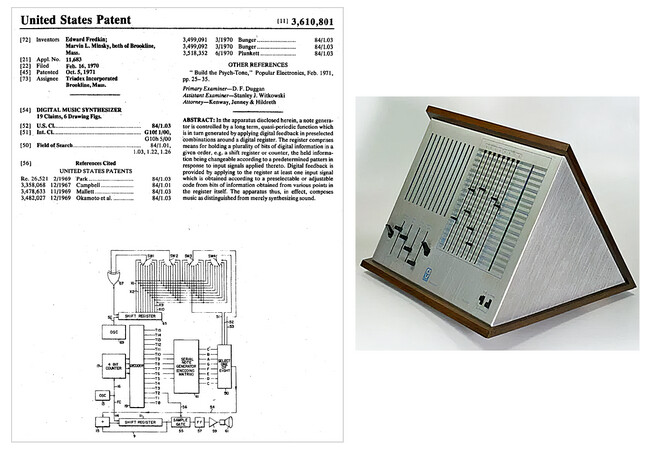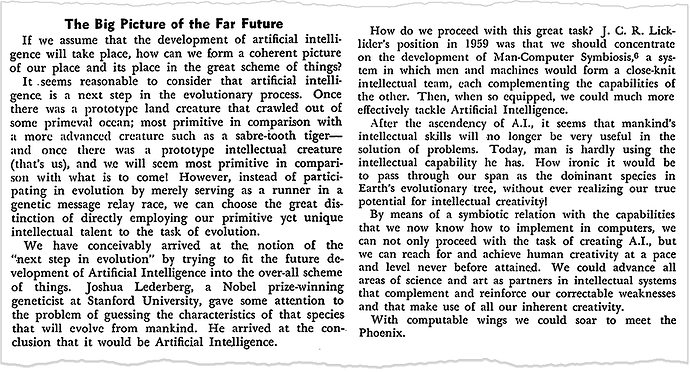Edward Fredkin died on 2023-06-13 at the age of 88. Stephen Wolfram, who knew Fredkin since 1982, has written a massive (35,000 word) recollection of what he calls Fredkin’s “improbable life”. How improbable was it? Consider this clip from Fredkin’s Wikipedia page.
Fredkin worked with a number of compaznies in the computer field and held academic positions at a number of universities. He was a computer programmer, a pilot, an advisor to businesses and governments, and a physicist. His main interests concerned digital computer-like models of basic processes in physics.
Fredkin’s initial focus was physics; however, he became involved with computers in 1956 when he was sent by the Air Force, where he had trained as a jet pilot, to the MIT Lincoln Laboratory. On completing his service in 1958, Fredkin was hired by J. C. R. Licklider to work at the research firm, Bolt Beranek & Newman (BBN). After seeing the PDP-1 computer prototype at the Eastern Joint Computer Conference in Boston, in December 1959, Fredkin recommended that BBN purchase the very first PDP-1 to support research projects at BBN. The new hardware was initially delivered with no software whatsoever.
Fredkin wrote a PDP-1 assembler language called FRAP (Free of Rules Assembly Program, also sometimes called Fredkin’s Assembly Program), and its first operating system (OS). He organized and founded the Digital Equipment Computer Users’ Society (DECUS) in 1961, and participated in its early projects. Working directly with Ben Gurley, the designer of the PDP-1, Fredkin designed significant modifications to the hardware to support time-sharing via the BBN Time-Sharing System. He invented and designed the first modern interrupt system, which Digital called the “Sequence Break”. He went on to become a contributor in the field of Artificial Intelligence (AI).
In 1962, he founded Information International, Inc., an early computer technology company which developed high-precision digital-to-film scanners, as well as other leading-edge hardware.
In 1968, Fredkin returned to academia, starting at the Massachusetts Institute of Technology (MIT) as a full professor despite the fact that he had never graduated from college. From 1971 to 1974, Fredkin was the Director of Project MAC at MIT. (Project MAC was renamed the MIT Laboratory for Computer Science in 1976.) He spent a year at Caltech as a Fairchild Distinguished Scholar, working with Nobel Prize-winning physicist Richard Feynman, and was a Professor of Physics at Boston University for six years.
Fredkin had formal and informal associations with Carnegie Mellon University (CMU) over several decades. His later academic interests were in the area of digital mechanics, which is the study of discrete models of fundamental process in physics. Fredkin has been a Distinguished Career Professor of Computer Science at CMU. and also a visiting scientist at MIT Media Laboratory. As of 2022, he was Distinguished Career Professor of Robotics at CMU.
Fredkin served as the founder or CEO of a diverse set of companies, including Information International, Three Rivers Computer Corporation, New England Television Corporation (owner of Boston’s then CBS affiliate WNEV on channel 7), and The Reliable Water Company (manufacturer of advanced sea water desalination plants).
Fredkin was broadly interested in computation, including hardware and software. He was the inventor of the trie data structure, radio transponders for vehicle identification, the concept of computer navigation for automobiles, the Fredkin gate, and the Billiard-Ball Computer Model for reversible computing. He has also been involved in computer vision, chess, and other areas of Artificial Intelligence research.
Fredkin also worked at the intersection of theoretical issues in the physics of computation with computational models of physics. He invented the SALT Cellular Automata family. Dan Miller designed and programmed the Busy Boxes implementation of Salt, with assistance from Suresh Kumar Devanathan. The early SALT models are 2+1 dimensional quasi-physical, reversible, universal cellular automata, that are second order in time, and that follow rules that model CPT reversibility.
Oh, and the Wikipedia passage I quoted doesn’t mention Fredkin’s private island in the British Virgin Islands and the Bond villain lair he built there, or his efforts to bring down the Soviet Union by introducing personal computers which would allow individuals to communicate without control by the Party. Here is Fredkin describing artificial intelligence in 1963.
Fredkin was a pioneer in cellular automata, and one of the first to suggest that the structure underlying the universe was a cellular automaton, with our laws of physics defined on a continuum simply effective theories of emergent phenomena from the fundamental discrete substrate. Fredkin’s work and that of his collaborators, Norman Margolus and Tommaso Toffoli, along with Stephen Wolfram’s independent investigations, were the major inspiration for Cellular Automata Laboratory, which Rudy Rucker and I developed in 1989 and is now available for free on the Web, running in any browser with a modern JavaScript implementation.
In 1970, Fredkin and Marvin Minsky invented and patented an electronic music composer they called “the Muse”.

It generated music using a feedback shift register and tone generator. Actually, Harry Pyle’s Mind Grenade, built in 1968, got there first. (My re-implementation was built in 1969.)
Wolfram’s long recounting of Fredkin’s adventures is idiosyncratic and occasionally abrasive, but then that’s Edward Fredkin—and Stephen Wolfram. I spent the time to read it yesterday and enjoyed it immensely. Treat yourself.
